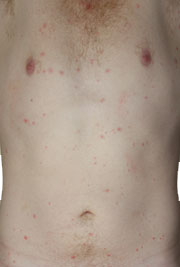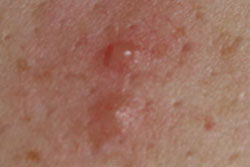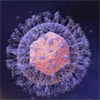- What is shingles (herpes zoster; HZ)?
- Statistics on shingles
- Risk factors for shingles
- Progression of shingles
- Symptoms of shingles
- Clinical examination of shingles
- How is shingles diagnosed?
- Prognosis of shingles
- How is shingles treated?
- References
What is shingles (herpes zoster; HZ)?

Shingles is caused by the activation of the Varicella-zoster virus. Varicella-zoster is the same virus that causes chicken pox, and shingles only occurs in people who have had chicken pox. Once a person has had chicken pox, the virus remains in nerve cells near the spine. Chicken pox will never reoccur if the virus is “reactivated”. Instead, a condition far worse than chicken pox develops: shingles.
Statistics on shingles
From 2000 to 2006, it has been estimated that 10 out of 1,000 Australians over 50 contracted shingles. The average age for contracting shingles is 68, and both men and women are equally as likely to contract the condition.
Risk factors for shingles
Chicken pox is the major predisposing factor to shingles, which follows usually decades later. Chicken pox is highly contagious; up to 97% of people have experienced chicken pox by age 40 and, accordingly, have produced varicella antibodies that remain in the nerves throughout their life to fight the virus.
The reactivation of the virus most commonly occurs in people who have a decreased immunity. This includes:
- The elderly;
- People with diseases that affect the immune system, like HIV;
- People with diseases that require treatment which has an effect on the immune system, such as treatment with chemotherapy for cancer;
- People with neoplasic diseases ;or
- Organ transplant recipients.
If you have health factors that put you at risk of shingles, make sure you learn to recognise the symptoms and are monitored closely by your doctor so that it can be treated immediately if contracted.
For the elderly and the otherwise healthy population who are not actively reminded of the risk, shingles is more likely to be allowed to progress further without intervention, and hence the risk of associated complications is greater.
Shingles is contagious only to those who have not had chicken pox. If someone without varicella antibodies is exposed to a person with shingles they can develop chicken pox but they cannot catch shingles from another person. Shingles is only something that develops when the varicella virus is reactivated.
Symptoms of shingles
The first symptoms of shingles may include:
- A general feeling of uneasiness;
- Headache;
- Photophobia; and
- Preherpetic neuralgia: which involves unusual skin sensations or pain.
After a couple of days the characteristic symptom of the condition develops which is the shingles rash. The rash is described as blistering, itching, painful and burning. Most commonly, shingles will develop on the thorax, followed by the head and neck (trigeminal nerve), sacrum and lower back.
The rash only occurs on one side of the midline of the body. First, clear vesicles appear, which then progress through postulation, ulceration and finally blistering. This development takes 2–3 days and then remains in the blistered state for up to one month.
Clinical examination of shingles
Shingles most commonly affects the thorax, followed by the head and neck (trigeminal nerve), sacrum and lower back.
The trigeminal nerve is involved in approximately 15–20% of shingles cases which, depending on the branch of the trigeminal nerve affected, can lead to:
- Oral ulcerations;
- Herpes zoster ophthalmicus, where the virus reactivates in the ophthalmic division of the trigeminal nerve; or
- Herpes zoster oticus, characterised by herpetic blisters presented in the external canal, pinna or the The corium and submucosa.
How is shingles diagnosed?

The rash develops on one side of the midline of the body (unilaterally) as clear vesicles, which are small circular blisters that contain fluid. The vesicles then develop into pustules which are similar to vesicles except they contain pus instead of clear fluid. This process is called pustulation. Following pustulation, the blisters turn into ulcers, which are inflamed breaks in the skin which finally crust up as sores.
If there happens to be any doubt about the diagnosis, shingles can be detected by analysing a skin cell scraping using laboratory techniques such as immunofluorescence assay or polymerase chain reaction.
Prognosis of shingles
A couple of days before the rash appears, individuals report general uneasiness, headache and photophobia followed, in some instances, by a preherpetic neuralgia which involves unusual skin sensations or pain. The rash only occurs on one side of the midline of the body. First, clear vesicles appear, which then progress through postulation, ulceration and finally blistering. This development takes 2–3 days and then remains in the blistered state for up to one month. Once the rash has disappeared, there may be some remaining scarring and pigmentation.
Shingles is painful due to the inflammation in the spinal cord; the severity of the pain experienced varies between individuals.
Shingles can be associated with serious complications that can occur once the rash has healed. However, this is becoming less common with advances in treatment. The risk of complications has been found to be higher in people who experience more severe rash eruption and pain during shingles.
Depending on the specific nerves affected by the virus, associated complications can include:
- Post-herpetic neuralgia;
- Visual disturbances and dry eyes; (in those affected with herpes zoster ophthalmicus)
- Myelitis;
- Vertigo, hearing loss, tinnitus (in those affected with herpes zoster oticus)
- Encephalitis;
- Pneumonitis;
- Hepatitis; or
- Dry mouth and taste impairment.
How is shingles treated?

The best therapy option is 7-day treatment with antiviral agents such as famiclovir, acyclovir or valacyclovir. If administered within 48 hours or, at the latest, 72 hours of rash onset, antiviral agents have been found to reduce pain intensity caused by the rash as well as the formation of lesions, vesicles and crusting.
Early administration of these agents is sometimes very difficult as many people, and even some doctors, may not know to recognise shingles in the early stages. That said, some people who begin the antiviral treatment very early will still develop associated complications such as post-herpetic neuralgia.
More information
 |
For more information on chicken pox, shingles and postherpetic neuralgia, as well as some useful videos, see Chicken pox, shingles and postherpetic neuralgia |
References
- Hawksley H. Managing pain after shingles: a nursing perspective. Brit J Nurse. 2006;15(15):814-8. Abstract
- Robb-Nicholson C. Does post-herpetic neuralgia raise C-reactive protein? [online]. Harvard Women’s Health Watch. 2006 [cited July 2009]. Available from: URL link
- Gnann JW, Whitley RJ. Herpes zoster. NEJM. 2002;347(5):340-6. Full text
- Gebo KA, Kalyani R, Moore RD, Polydefkis MJ. The incidence of, risk factors for and sequale of herpes zoster among HIV patients in the highly active antiretroviral era. J Aquir Immune Defic Syndr. 2005;40(2):169-74. Abstract | Full text
- Ross AM, Flemming DM. Chickenpox increasingly affects preschool children. Commun Dis Public Health. 2000;3:213-5. Abstract
- Grimard BH, Larson JM, Mcbrayer RH. Scalded mouth with headache. Herpes zoster (shingles). Am Fam Physician. 2008;77(9):1307-9. Full text
- Chidiac C, Bruxelle J, Daures JP, et al. Characteristics of patients with herpes zoster on presentation to practitioners in France. Clin Infect Dis. 2001;33:62-9. Abstract | Full text
- Nithyanandam S, Dabir S, Stephen J, Joseph M. Eruption severity and characteristics in herpes zoster ophthalmicus: correlation with visual outcome, ocular complications, and postherpetic neuralgia. Int J Dermatol. 2009;48(5):484-7. Abstract
- Uscategui T, Dorée C, Chamberlain IJ, Burton MJ. Antiviral therapy for Ramsay Hunt syndrome (herpes zoster oticus with facial palsy) in adults. Cochrane Database Syst Rev. 2008;(4):CD006851. Abstract | Full text
- Gorlin RJ, Cohen MM, Hennekam RCM. Syndromes of the Head and Neck (4th edition). New York: Oxford University Press; 2001. Book
- McKendrick MW, McGill JI, White JE, Wood MJ. Oral acyclovir in acute herpes zoster. Br Med J. 1986;293:1529-32. Abstract | Full text
- Hardy D. Relief of pain in acute herpes zoster by nerve blocks and possible prevention of post-herpetic neuralgia. Can J Anaesth. 2005;52(2):186-90. Abstract
- Opstelten W. Design issues for studies into prevention of chronic pain: Lessons from post-herpetic neuralgia. Anaethesia. 2004;59(3):213-5. Full text
- National Institute of Neurological Disorders and Stroke: NINDS Shingles Information Page [online]. NINDS, 2010 [cited 2010, Dec 28]. Available from: URL link
Symptoms of This Disease:
All content and media on the HealthEngine Blog is created and published online for informational purposes only. It is not intended to be a substitute for professional medical advice and should not be relied on as health or personal advice. Always seek the guidance of your doctor or other qualified health professional with any questions you may have regarding your health or a medical condition. Never disregard the advice of a medical professional, or delay in seeking it because of something you have read on this Website. If you think you may have a medical emergency, call your doctor, go to the nearest hospital emergency department, or call the emergency services immediately.







